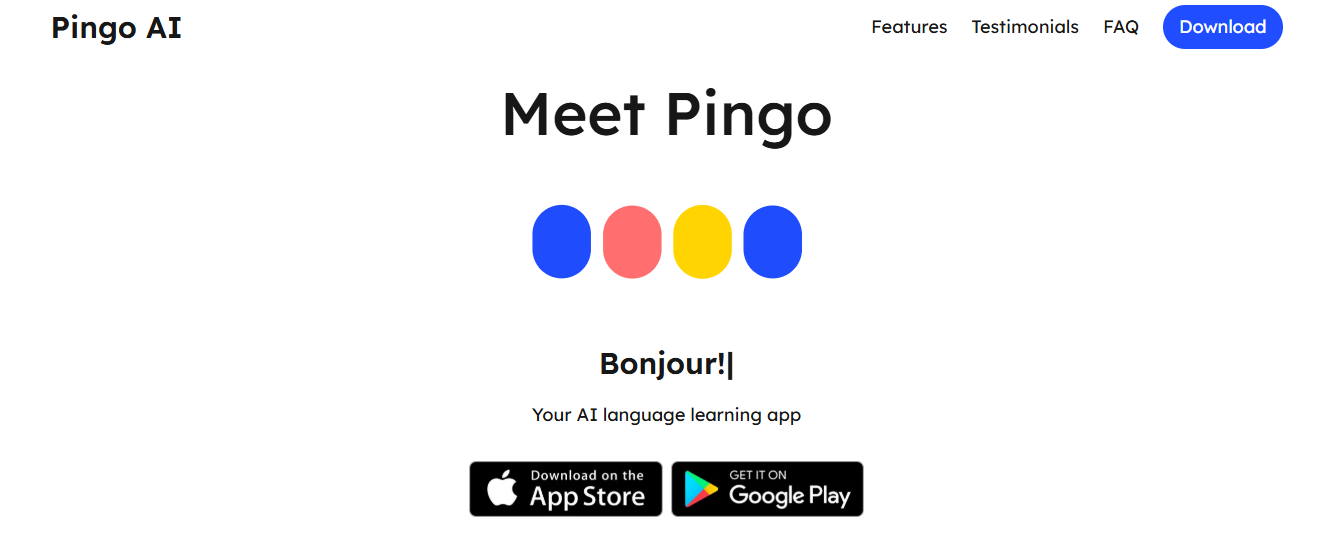Is Vietnamese a Hard Language to Learn? What You Should Know

Michael Xing, Founder of Pingo AI
You want to know whether Vietnamese is hard to learn because you have a trip, a job, or family ties, and you also wish to get practical tips on how to learn a language fast. Vietnamese can look intimidating with its tones and accent marks, but its grammar is simpler than many learners expect, while pronunciation and listening are the real hurdles for most people. This article breaks down key points such as tones, tone rules, the Romanized alphabet, everyday vocabulary, and study habits and gives clear steps and resources so you can judge how hard Vietnamese will be for you and how to make real progress. Ready to find out?
Pingo’s AI language learning app turns those steps into practice with short lessons, real-time feedback on tones and pronunciation, and daily exercises that fit your schedule.
Summary
- Pronunciation and tones are the primary early barriers in Vietnamese learning, with approximately 90% of learners reporting difficulty due to the language's tonal nature.
- Vietnamese grammar and the Latin-based alphabet lower entry friction, and benchmarks suggest about 1,100 hours of study are typically needed to reach a proficient level.
- Passive methods show their limits: only about 15% of learners achieve fluency within a year, which reflects how many rely on non-speaking study approaches.
- High-frequency micro-sessions work best, for example, a 30-minute template of two minutes warmup, six minutes targeted sounds, ten minutes guided dialogue, then recording plus two quick self-corrections.
- Small public-facing goals cut the embarrassment barrier, for instance, ordering a coffee within three tries reduces avoidance and creates momentum toward more frequent speaking.
- Immersion helps but is not required; over 90% of learners report that speaking from day one accelerates progress, and structured, corrective practice can reproduce immersion benefits without relocating.
- Pingo AI's AI language-learning app addresses this by offering short, conversation-first lessons with real-time tone and pronunciation feedback, and daily practice opportunities that build the corrective loop learners need.
Is Vietnamese A Hard Language To Learn?

Vietnamese is not intrinsically more complex than many other languages; it asks you to relearn how you listen and speak, rather than memorize exceptions. With deliberate, conversation-first practice, you can make rapid, measurable gains without mastering every rule first.
Why Does the Sound Feel So Alien at the Start?
Pronunciation and tones dominate the early experience, and that’s where most learners stumble, because changing tone changes meaning. Approximately 90% of learners find Vietnamese pronunciation challenging due to its tonal nature, which explains why beginners feel blocked by listening and speaking before they’ve even tackled vocabulary.
How Does This Challenge Play Out When You Practice?
When we ran eight-week conversational practice blocks focused on honest dialogue, the pattern became clear: learners who practiced short, daily speaking sessions stopped overthinking tones and started matching native pitch within weeks. That shift felt less like a technical fix and more like retraining an ear, similar to learning to hear intervals in music; once the ear knows what to listen for, meaning follows.
Is the Writing System or Grammar an Extra Barrier?
No, and that’s the practical upside. Because Vietnamese uses the Latin alphabet, you can begin reading immediately, which accelerates vocabulary acquisition. Grammar gives you fewer traps, since verbs don’t conjugate and nouns rarely change form, so your study time buys more usable output rather than rote exception-spotting.
What Do Most Learners Try First, and Where Does That Approach Break Down?
Most learners rely on vocabulary lists and grammar drills because they feel efficient and familiar. That works for recognition, but the hidden cost is obvious: errors fossilize without corrective speaking practice, and confidence stalls when you try to talk.
Solutions like Pingo AI change that dynamic by offering an always-available, native-sounding AI tutor with personalized Tutor Mode and instant, actionable feedback across hundreds of everyday scenarios, so practice compresses awkward silence into repeated, low-pressure tries that build confidence faster.
How Fast Should You Realistically Expect to Speak Fluently?
Benchmark statistics are blunt but helpful. Only 15% of learners achieve fluency in Vietnamese within a year, reflecting how many still rely on passive study methods. If you prioritize daily speaking, immediate feedback, and contextual practice, you shift the failure mode from “stalling confidence” to “compounding speaking wins,” which shortens the path to usable fluency.
That simple breakthrough, turning listening practice into confident speaking through repeated, native-mode conversation, changes everything about how you measure progress. But the most surprising part of this story is what happens after you stop being afraid to speak.
Related Reading
Reasons Why Vietnamese Isn't So Hard to Learn

Vietnamese is easier than it looks because its surface oddities hide straightforward, learnable systems you can master with practice and the right approach. Once you move past the initial shock of tones and focus on predictable building blocks, progress becomes fast and reliable.
How Does the Alphabet Help You Speak Sooner?
When we ran focused vowel-and-diacritic drills with beginners over a short module, the pattern became obvious: knowing the sound set and accent rules turns written words into reliable pronunciation guides. That means when you see a new word, you can say it aloud with far more confidence than in languages with opaque spelling.
Learners who concentrate on vowels first stop guessing and start producing, which reduces the paralysis that makes practice feel pointless.
Why Does the Grammar Feel Forgiving in Real Conversation?
The lack of verb conjugations and gendered nouns is not only convenient but also reduces the learning curve. You can build functional sentences from day one and iterate by trying variations, because mistakes don’t explode into a dozen exceptions. I treat Vietnamese grammar like a set of modular parts you can reassemble on the fly, and that reduces the cognitive load most learners carry into every practice session.
Why Do Tones Seem So Unnatural, and How Do You Fix That Discomfort?
This discomfort shows up reliably among English speakers because English uses pitch for nuance rather than meaning. The problem intensifies when short, two- or three-letter words carry different meanings solely by tone. The practical fix is not more rote memorization; it is targeted listening and imitation, followed by tiny speaking wins.
Pattern-based practice, for example, matching native pitch contours in 30-second shadowing rounds, retrains your ear and makes tones feel natural rather than awkward.
How Should Exposure Be Turned into Progress, Not Passive Noise?
Passive exposure helps, but only if you turn it into exact, repeatable tasks. Try reading one sign aloud and recording it, or asking a vendor to repeat a phrase and then immediately imitating it. This converts ambient language into micro-lessons that recalibrate your pronunciation and comprehension.
The Cost of Flashcards
When learners adopt these micro-habits, the everyday environment becomes an active tutor rather than background noise. Most people rely on flashcards and grammar lists because those methods feel efficient. That’s understandable; lists are simple to schedule and measure. The hidden cost is that without consistent corrective speaking practice, errors fossilize and confidence stalls.
Instant Corrective Feedback Loop
Solutions like AI language learning app change that dynamic, by offering an always-available native-sounding tutor with instant corrective feedback, personalized Tutor Mode, and hundreds of real-life scenarios, so you get the corrective loop you need without the friction of finding partners or scheduling lessons.
How Do You Break the Embarrassment Barrier That Stops Practice?
When we coached learners to set tiny public-facing goals, like ordering a coffee in Vietnamese within three tries, avoidance dropped sharply. Small, bounded challenges reduce the social risk and create momentum; success breeds more attempts. Record, compare, and repeat—this simple loop defeats perfectionism faster than polishing vocabulary lists ever will.
What Turns Vietnamese from Obstacle to Bridge?
Think of tones and diacritics as tools that unlock nuance, not traps that block you. With deliberate practice that emphasizes listening, small speaking goals, and context-driven feedback, Vietnamese becomes a direct route to connection. That shift in perspective—from fearing noise to treating mistakes as data—changes how quickly you speak and with whom.
Conversation-First Fluency
Pingo's AI language learning app offers conversation-first practice powered by expressive AI, with adaptive feedback and two tailored modes for beginners and advanced learners to make speaking feel natural. Start speaking with Pingo for free and experience how fast practice, not memorization, gets you conversational.
That solution sounds complete, but the real question everyone wants answered next is far more personal and surprising.
Related Reading
- Best Programs To Learn Japanese
- Types Of English Language Courses
- Best Program To Learn Russian
- Best Ways To Learn English
- What Is The Best Language To Learn
- Is Italian A Hard Language To Learn
- Is Dutch Hard To Learn
- Is Chinese A Hard Language To Learn
- Best App To Learn Portuguese
- Best App To Learn Polish
- Is Arabic Hard To Learn
- Best Books To Learn German
- Best Ways To Learn Italian
- How Long Does It Take To Learn Dutch
- Best Program To Learn Spanish
How Long Does it Take to Learn Vietnamese?

You can make noticeable conversational progress in a few months with daily, speaking-focused practice, and reach professional-level fluency only after sustained, focused study. Most learners reach fluency in 12–18 months with 1,100 hours of research and consistent daily practice. How fast you cross those milestones hinges on what you do in each practice hour, not just how many hours you log.
What Should Most Study Hours Focus On?
Aim each session at one narrowly defined outcome, not general exposure. A practical split I use for busy learners, scaled to any session length, is:
- Targeted pronunciation drills
- Short active listening
- Immediate speaking production
- Error-focused review
Treat a 30-minute slot like a mini-experiment: two minutes warmup, six minutes targeted sounds, ten minutes guided dialogue that forces you to use new words, then recording plus two quick self-corrections. This forces the ear, voice, and correction loop to converge within the same practice window, making progress measurable and repeatable.
How Do You Measure Progress So You Don’t Stall in Plateaus?
- Set outcome-based checkpoints. For example, can you sustain an unscripted two-minute exchange without falling back to English, three times in a week, with fewer than three pronunciation breakdowns per exchange? If yes, raise the bar.
- Use short, repeatable metrics:
- Percent of native-speech words understood in a 60-second clip
- Number of distinct, correctly pronounced target words in a single take
- Time to respond to a prompt under five seconds
- Record every attempt and compare waveforms or timestamps to see objective change, not vague impressions.
Why Do Most Well-Meaning Routines Waste Time?
Most learners follow familiar patterns: phrasebooks, intermittent classes, and passive listening because these feel safe and familiar. That approach is understandable, but it creates a hidden cost, errors that fossilize, and long stretches of stalled confidence when you try to speak live.
Compressing the Corrective Loop
Solutions like Pingo AI sidestep that trap by providing an always-available, native-sounding tutor, personalized Tutor Mode, and instant corrective feedback across hundreds of realistic scenarios, which compresses the corrective loop and lets learners iterate until muscle memory replaces hesitation.
What Commonly Derails Steady Practice, and How Do You Fix It?
The failure modes repeat: inconsistent frequency, swapping methods every few weeks, and practicing without immediate corrective feedback. The fix is constraint-based: when time is scarce, keep sessions identical so you can compare performance; when motivation dips, make one public micro-goal, like ordering food in Vietnamese within three attempts over two days; when errors repeat, isolate the smallest unit that breaks and drill it for five minutes daily.
Think of progress as training a camera to lock focus, making minor adjustments every session until the subject is sharp without thinking.
Does Immersion Matter, or Can Structured Practice at Home Match It?
Immersion accelerates exposure, but it is not the only path to fluency, as learning Vietnamese to a proficient level typically requires around 1,100 hours of study. High-quality, high-frequency practice that simulates fundamental interactions and includes corrective feedback reproduces most of the benefits of immersion, because the core engine of progress is corrective, contextual speaking practice rather than passive time in an environment.
The pattern I want you to notice is unsettling and straightforward: scattered advice and off-topic discussions bleed time, and when learners spend more than three months chasing varied hacks, their speaking confidence often falls rather than rises.
The Missing Repeatable Feedback Loop
That’s where the fundamental constraint shows up, and it isn’t a grammar rule or a vocabulary gap—it’s the missing, repeatable feedback loop you can build into every single practice session. But the next twist in this story is harder to predict than schedules or drills; it has less to do with technique and more to do with how you handle the first few awkward attempts.
5 Best Tips for Learning Vietnamese

1. Start with the Vietnamese Alphabet and Pronunciation
- Build on the basics you already learned, then focus on targeted drills that force precision rather than passive recognition.
- Use minimal-pair drills that isolate tricky vowels and tones for two to five minutes each session, and run short, recorded shadowing rounds where you match pitch and length exactly.
- Use Talkpal or similar tools for interactive pronunciation practice, then compare your recordings to native audio, paying attention to where your pitch contour diverges.
- Treat tone errors as a signal to shrink the practice unit: if a phrase breaks consistently, break it into syllables and retest after five repetitions. Small, measurable wins here are the difference between nervous silence and speaking with confidence.
2. Build a Strong Vocabulary Base
- Make vocabulary functional from day one. Instead of memorizing long lists, create sentence-linked flashcards that force production: the front of the card shows a situation, and the back asks you to write three sentences using target words.
- Group words into scenario banks you will actually use, for example, 30 travel phrases, 50 food phrases, 20 family phrases, and practice swaps inside those banks until response time drops.
- Use an SRS for scheduling review, but prioritize active production during each review: say the sentence aloud, record it, and immediately correct one recurring error.
- Aim for steady, small gains—consistency beats volume.
3. Practice Listening and Speaking Regularly
Make speaking unavoidable. Short, high-frequency speaking blocks beat long, infrequent sessions because they force the corrective loop to run often. Use slowed audio to map unfamiliar rhythms, then incrementally raise speed until you can shadow at normal pace, and add transcription drills to force focused listening.
Prioritizing early speaking accelerates progress, so convert even five minutes of study into speaking practice.
Roleplay and Instant Correction
Accordingly, pair your drills with real conversational practice: roleplay 60-second scenarios, record and timestamp errors, then immediately repeat the scenario and target those exact mistakes. Platforms, language partners, or tutors that give instant corrective feedback let you iterate faster than waiting days for corrections.
Also, keep perspective, this pattern appears across classroom and travel contexts: once learners accept short, imperfect exchanges as data rather than failure, confidence compounds quickly.
4. Understand Vietnamese Grammar Basics
- Use grammar as a toolkit for improvisation, not a checklist to memorize.
- Build a small set of sentence frames:
- Requests
- Offers
- Questions
- Polite refusals
- Practice slotting new vocabulary into those frames until assembly becomes automatic.
- Make a one-page cheat sheet of measure words, common particles, and time markers, and use it as a scaffold during speaking drills so you can keep fluency while you correct form later.
Think of grammar like Lego bricks, not rules that trap you; the faster you can recombine a few stable pieces, the quicker you will speak fluidly under pressure.
5. Immerse Yourself in Vietnamese Culture
Turn curiosity into a practice engine. Create micro-immersion tasks tied to everyday habits: narrate your cooking steps in Vietnamese, read three social media captions aloud and summarize them, or change your phone language and respond to simple prompts. These routines turn cultural interest into repeatable speaking opportunities and make vocabulary memorable by tying it to action.
Practicing this way also addresses emotional barriers—learners report excitement and determination when cultural tasks are tangible, and that emotion is what keeps them showing up when practice gets hard.
Fossilization from Fragmented Practice
Most learners treat repetition and conversation as separate steps, and that works early on, but as errors accumulate, the familiar approach fragments into stalled confidence. The hidden cost is clear: without an always-on corrective loop, mistakes fossilize, and you stop risking speech.
Platforms like Pingo AI provide native-sounding, always-available conversation practice with instant, actionable feedback and a Tutor Mode that personalizes correction, so learners find the corrective loop without scheduling friction and iterate until speaking feels natural.
Start Learning a Language with Pingo for Free Today

Speaking aloud feels risky, and if you want low-pressure, conversation-first practice that turns small tries into steady gains, consider giving Pingo AI a try to make talking a habit rather than a hurdle. Over 1 million users have started learning a language for free with Pingo, and 90% report improved language skills within 3 months of using it.
Related Reading
- Best Online French Course
- How To Learn Brazilian Portuguese
- Best Way To Learn Vietnamese
- Best Apps To Learn Dutch
- Best Online Arabic Courses
- Best Chinese Language Learning App
- Best French Language Books
- Best YouTube Channels To Learn Spanish
- Best Way To Learn Korean Online
- Best Portuguese Language Course
- Best App To Learn Turkish
- Best Way To Learn Turkish